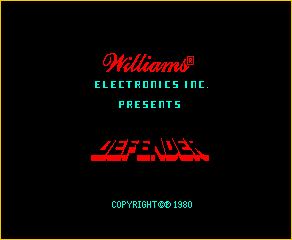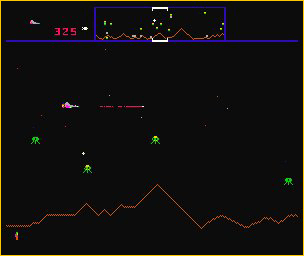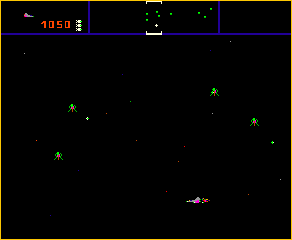
> Home Base
> Classic Archives
> Game Reviews
> Features
> Sound Fixes
> Guess the Game
> Links
> Flyers
> The DUMP!
> Glossary
> Game Timeline
> About Us
> Contact Us
We love to be linked. Why not use our button below on your site!

Do you want 'Hard-Core', real 'Hard-Core'. It doesn't get much harder than William's Defender. The very name Williams is enough to tell you (no pussy's need apply). Only the bravest would dare step up to the threshold and have a go at Defender. If ever a game shouted out to you 'Come and have a go if you think your hard enough!' its Defender.
With five buttons and a joystick, you needed big balls to engage this game. Only someone with a geek name like Eugene Jarvis could possibly have the warped mind to program such a game. The plot was simple, rid a hostile planet of aliens and save the last humans from being mutated. Thus you were 'The Defender' and the odds were seriously stacked against you.
Defender was the game that launched Williams into the video game arena (and what an entrance). But the game very nearly didn't make it to the arcades. With only 2 weeks to go before the 1980 Amusement Machine Operators of America convention the game was still unfinished. The game play was still being developed and when the show commenced the game that stolel the limelight was another classic friend of ours PacMan. The conventional hierarchy of the time thought the game was just too damn hard.

Defender
'attract mode' screenshot
It
had too many buttons and controls which seemed difficult to master, the thought
was that gamers would just walk away from it having spent their hard earned
credit in a matter of seconds.
Ahh its great when the experts are wrong isn't
it.
Gaming was moving on and veterans of SPACE INVADERS and Asteroids amongst
others were only too eager to test and display their skills on a bigger stage,
and Defender fitted the bill. The game was duely released to the arcades and became
an instant hit amongst hard-core gamers, and the rest as they say, is history.
At the next A.M.O.A guess which game was voted 'Video Game of the Year',
yeah baby Defender.
Defender today shares the title of 'Highest Grossing Video Game of All Time' together with its great rival PacMan. As we have said, all great classic games spawn sequels, Defender is no different. Stargate followed and Eugene Jarvis went on to create a catalogue of games unequaled in the games world:- Robotron 2084, Joust, Sinistar and Bubbles.

Defender
screenshot I
Although by today's standards Defender's graphics look simplistic at the time they used a near unheard of 16 colours. The screens wrap around effect created a larger play area than had been seen before and the sounds were true sci-fi. Who can forget that sound when you dropped a credit into the attract mode, which incidentally was programmed in a mere 5 hours.
Another first was the scanner at the top of the screen so that you could keep in contact with what was happening around other precincts of the game play area. This helped to immerse the gamer in his environment as events would appear to be happening in real time around the planet away from your range of sight, adding to the tension and anxiety.
The challenge became harder as you progressed through the screens. New and more lethal aliens would be thrown up against you with an ever increasing aray of weaponry. Bombers, Pods, Swarmers and Baiters all joined the fray. To help you of course you had a limited supply of Smart Bombs which if used correctly could rack up the points. Additionally the now compulsory, (near suicidal), Hyper-Space button and a reverse thruster accompanied by your trusty laser cannon.
Saving humans from mutation clocked up the points but was often a dangerous game to play. Real Big-Dogs would play the ultimate dare game by leaving just one humanoid on the planet surface and defending them to the hilt, hardly moving from the immediate space around them. Only real Space-Jocks need apply however.

Defender
screenshot II
Clocking this game was real proof of gaming finesse and the Hall of Fame mean't that you could be immortalized in lights. In 1982 Time magazine featured a now famous article about one such jock named Steve Juraszek. Evidentally he spent 17 hours playing Defender straight. He racked a score of 15,963,100. Another urban myth or rumour was that a guy Jarvis knew who worked at Boeing quit his job to play Defender full-time. Imagine a story like that in today's gaming world, it would just not happen!
Summary
Defender was a humbling often humiliating game, but
there was something that made you come back to it time and time again. Together
with Jarvis's other great invention Robotron 2084, Defender probably swallowed
more of my credits than any other game. In my humble opinion the main man 'Eugene Jarvis'
is a gaming God. Without his games my childhood would have been far more impoverished.
Few programmers achieve as much fame as their games do, but Eugene's legacy lives
on. He still programs to this day, having seen off younger, newer programmers
in their droves. Williams would not be synonymous with quality games today
if it was not for him. There are many web sites around the world rightly dedicated
to the man and his games. I take my hat of to you Eugene Jarvis, to coin a phrase 'May you live long
and prosper'.
Overall
Classic Game Rating - 8.75